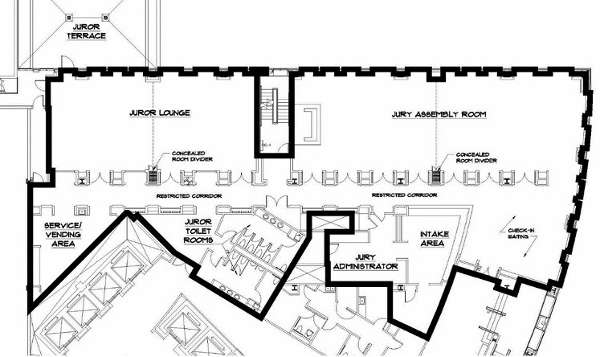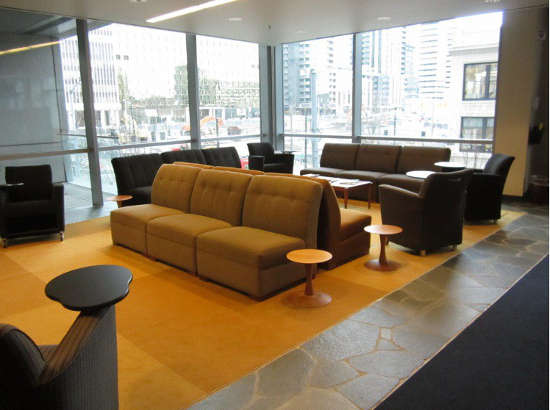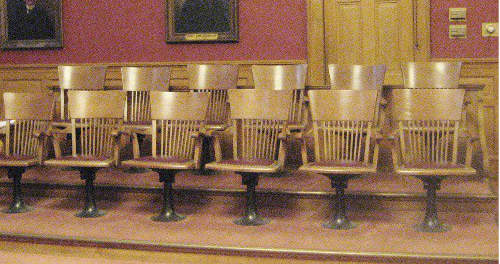Six months ago, I received my first ever summons for jury duty. I had somehow eluded it my entire life, but my number was finally up! Serving shed light on a jurors perspective during courthouse planning.
Having worked as a court planning consultant for many years, I’ve seen numerous courthouses inside and out. That includes the whole gamut of jury facilities, from the most basic to the most lavish. And I have a fairly solid understanding of how the judicial system works.
But I had never served on a jury, so I was intrigued to see a courthouse from the perspective of an actual participant. And as a court planning consultant, I wondered how the facility would measure up. Would the jury facilities be comfortable, functional, and safe?
As I reported for duty, little did I know what a fascinating experience was about to unfold. I was one of 12 people selected to serve on the jury for a very complex first and second degree assault case. During my two days of service, I learned much about law and order, and I also experienced firsthand the important role facilities play in the administration of justice.
Jury Duty – Just Show Up!
As the saying goes, 80% of life is showing up. This is often true of jury duty, considering so few from the jury pool are selected to serve. But sometimes even showing up can be a challenge! Many courthouses are located in busy downtown locations, and it can be a daunting task to find the courthouse and parking. When I arrived for jury duty, I was relieved to find signs clearly marking the courthouse and parking. There was sufficient parking and I arrived at the security screening area in plenty of time. The court security personnel were helpful and directed me to the jury orientation room on the second floor. Being welcomed into the courthouse in such a smooth and friendly manner eased my anxiety about the process.
How are potential jurors greeted at your courthouse? Is there clear signage, plenty of nearby parking, and a warm welcome at the security checkpoint? Remember, the jurors are there to perform a civic duty, not to go on trial!
Jury Facilities Orientation – Getting the Scoop
As a court planning consultant, I’ve learned how important it is for the check-in and orientation process to make a positive impression on prospective jurors. For many, this is their first introduction to the judicial system, and they may have questions or be anxious about the process. To accommodate jury assembly, courthouses typically provide rooms adequately sized for larger jury pools, with comfortable seating, coat and personal property storage areas, restrooms, and vending. Magazines and televisions are often provided to occupy jurors during a long waiting period.
My assembly room had none of the above. Magazines would have been a dream! The orientation room was rather small and crowded, with a U-shaped table and chairs lined up against the wall and inside the U – certainly not the most welcoming setting for jurors. I had to squeeze by several people to find a seat along the wall. Restrooms were all the way down the hallway and no water was available. It wasn’t terrible, but it sure would have made for a nicer experience if the layout had been closer to the one pictured below!

Ideal Jury Facilities Assembly Room
To take the ideal scenario a step further, below is a picture of a jury assembly room in a newer courthouse that goes well beyond minimal standards. This room is spacious, well-furnished, and offers spectacular views of the surrounding cityscape. As a bonus, the space can also be used for court-sponsored civic events. Clearly, this particular court had a vision of jury assembly as a welcoming and comfortable space for prospective jurors.
What kind of message do your jury facilities orientation send? Are they cramped and lacking in amenities as mine was, or do they make the jurors feel comfortable and possibly, just possibly, even a little bit special?

Modern Jury Assembly Room
Jury Selection – Wait, Me?
The jury selection process is often held in a courtroom, with the judge presiding over the proceedings and the defense and prosecution at their respective tables. As jurors, we were ushered into a nicely sized and well-appointed courtroom, and seated in the spectator area. We had a direct view of the defendant for the entire selection process, which took approximately 90 minutes. During this time, the trial judge began voir dire, the preliminary examination of jurors by the judge and counsel. At times, a white noise machine was used effectively to mask conversations at the bench. Overall, the space was appropriate for the function and helped us stay connected to the process.
Where is your jury selection held? Is the courtroom adequately sized with appropriate seating, sightlines, and acoustics?
For me, the jury selection process concluded with being selected for the jury and seated in the jury box as Juror #10. I passed through the “striking the jury” phase and found myself as an actual juror for the first time. The trial was about to begin!
Jury Trial - The Main Act
After being provided with basic instructions on the process, we were ushered back in to the courtroom for the trial. As the trial began, I noticed how important sightlines and audio were for these proceedings. We had a direct view of every part of the courtroom – spectator well, defense table, prosecution table, witness stand, and bench. The judge also had unobstructed views, which is extremely important to keep proceedings fair and orderly. A few of the witnesses were very soft-spoken, and the acoustics in the courtroom made it difficult to hear. I was relieved when the jury foreman finally asked for the sound to be amplified. Acoustics are critical in a courtroom to ensure all the evidence is heard.
The deputies were stationed at the front and rear of the courtroom, and I felt very safe. This was especially important to me when the key witness and reported victim was on the stand, and the situation became very tense.
Because jurors sit in the jury box for hours at a time, and often for long days or even weeks, the comfort of the jury box is extremely important. Jurors should not be distracted by a hard, uncomfortable chair, as depicted in the photo below.

Wooden Jurors’ Chairs
Focusing on a long and complicated trial proceeding can be challenging under any circumstances. Well-padded chairs, preferably swivel chairs, make it much easier for jurors to focus. The jury box we sat in had comfortable wing chairs. A padded swivel chair like the ones shown below would have been even better, but I can vouch for the fact that comfort was a key in keeping my attention focused on the proceedings.

Padded Jurors’ Chairs
What about your court? Have you ever sat in the jury box during a mock trial to ensure that sightlines and acoustics are up to par? And what about comfort? Which picture above does your jury box most closely resemble?
Jury Deliberation – Getting to the Verdict
The jury deliberation room is not only a place for final deliberations, but also the place jurors “hang out” during breaks. During our two-day stint, we spent a considerable amount of time in the jury deliberation room.
The jury facilities deliberation room must be in a restricted area to maintain the confidentiality of deliberations and the integrity of the process. The room must also be sealed off acoustically so that even the courtroom deputy stationed outside is not privy to deliberations. Our jury deliberation room was appropriately located relative to the courtroom in a restricted corridor off the back entrance to the courtroom.
As with the jury box, comfort is critical in a jury deliberation room. Jurors can spend hours at a time in this space. This happened during our case while the judge researched a key point of the law. The 10-minute break soon turned into a 90-minute break before we were eventually dismissed for lunch.
Unfortunately, our jury room was adequate at best. The table was just large enough to fit all 13 of us (including the alternate). We had to squeeze by each other to get to the service room, where there was a small refrigerator with bottled drinks and a small unisex restroom. There was also a second restroom in the main room right next to the juror table. It would be far preferable to have dedicated men’s and women’s restrooms in a separate room near the service unit.
The jury deliberation room shown in the following photo is a good example of what a jury facilities deliberation room should ideally look like.

A Well-furnished Jury Deliberation Room
Overall, our jury deliberation room worked but was not ideal. It certainly did not look like the picture above. If we had had to spend more than two days on the trial, I might have gone slightly stir crazy in such close quarters with no real amenities other than unisex restrooms and small bottles of water.
Perhaps the most concerning aspect for me was the experience of walking to my car during our lunch break. The prime witness’s daughter was parked right next to my car. It occurred to me that this type of situation – where she could have tried to speak to me or even influence me in some way - should have been avoided. Even more unsettling was encountering the defendant and his family, who were sitting at the front of the courthouse café, as I walked past after lunch. The entire jury also passed them several times in the hallways when being led from the assembly room to the deliberation room. It surprised me that this type of potential contact would be allowed. From my experience, there should be separation of circulation patterns to avoid such encounters, to keep the jury safe, and to uphold the fairness of the trial.
Do your jury deliberation rooms and circulation patterns provide a sense of comfort and security for your jurors? Have you ever encountered an instance where the trial could be jeopardized by encounters between the jury and trial participants?
My Closing Argument
Overall, the jury facilities in our small county courthouse functioned adequately. Had the trial been longer, the jury deliberation room would have detracted from the overall experience. I cannot emphasize strongly enough how important comfort and amenities are in helping jurors stay sane during the long stretches of time they must spend in jury deliberation.
And now for the verdict you’ve all been waiting for (even though this has nothing to do with the main point of my blog). We, the jury, found the defendant Not Guilty. Not because we were sure of his innocence, but because the prosecution didn’t make a compelling enough case. Plus, the prime witness for the prosecution was extremely unreliable and unstable, having changed her story multiple times and also having threatened the prosecution. (As an even more unrelated side point, there were some very dramatic courtroom scenes that made the case completely riveting. The defense attorney was a real character who brought to mind the antics of Perry Mason and the O.J. Simpson Dream Team. It was truly made for TV!)
One last thing – a thank you note arrived from the judge about one week after we served. I thought that was a very nice touch. I wonder if this is standard practice for most courts?
The next time a jury summons arrives in your mailbox, brace yourself! You may be in for the experience of a lifetime.





.jpg)
.jpg)
.jpg)
.jpg)
.jpg)
.jpg)


-1.jpg)
.jpg)
.jpg)

